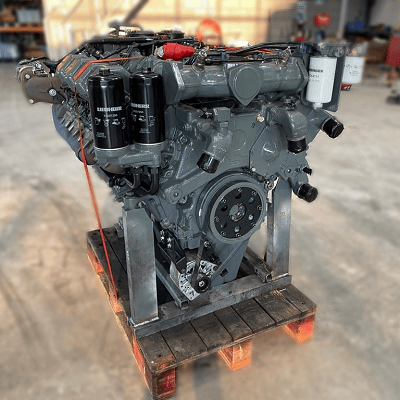The process of a dyno test on a Liebherr engine

When it comes to heavy machinery, reliability and power are paramount. Liebherr, a name synonymous with innovation and excellence in engineering, stands tall as a pioneer in the realm of heavy equipment and machinery. From towering cranes to robust excavators, Liebherr’s engineering prowess extends to the heart of these machines. We delve into the world of dyno testing a Liebherr engine, uncovering the meticulous process behind unleashing the raw power concealed within.
The foundation of excellence
Before we embark on the journey of dyno testing, it’s crucial to understand the foundation upon which Liebherr engines are built. With decades of engineering expertise and commitment to quality, Liebherr engines are crafted to withstand the most demanding environment and deliver unparalleled performance. Each component is meticulously designed and rigorously tested to ensure reliability, efficiency and longevity.
The process
1 Preparation: The engine undergoes meticulous preparation before being mounted onto the dynamo meter. This includes ensuring all connections are secure, fluids are filled to the appropriate levels, and sensors are properly calibrated.
2 Mounting: The engine is carefully mounted onto the dynamometer, a specialized device designed to simulate real-world operating conditions. Precision is paramount during this step to ensure accurate results.
3 Initial checks: Once mounted, a series of initial checks are conducted to verify proper alignment, connection integrity, and functionality of all engine systems.
4 Warm-up: The engine is started and allowed to warm up to operating temperature. This ensures consistent results and minimizes the risk of damage during testing.
5 Baseline testing: With the engine warmed up , baseline tests are conducted to establish initial performance metrics. This includes measuring power output, torque, fuel consumption, and emissions at various RPM levels.
6 Load testing: The engine is subjected to progressively increasing loads to simulate different operating conditions, such as idle, partial load and full load. This allows engineers to assess performance across the entire operating range and identify any potential issues or optimization.
7 Data analysis: Throughout the testing process, data is continuously collected and analyzed in real-time. Advanced instrumentation and software are used to monitor performance metrics and identify trends or anomalies.
8 Optimazation: Based on the data analysis, adjustments may be made to optimize engine performance. This could involve fine-tuning fuel injection timing, adjusting air-fuel ratios, or optimize turbocharger boost pressure.
9 Validation: Once testing is complete, the results are meticulously reviewed and validated against predetermined criteria and specifications. Any deviations or anomalies are thoroughly investigated to ensure accuracy and reliability.
10 Reporting: Finally, a comprehensive report is generated detailing the results of the dyno testing, including performance metrics, observations, and any recommendations for further optimization or refinement.
The outcome of dyno testing
Dyno testing a Liebherr engine is more than just a routine procedure – it’s a testament to the unwavering commitment to excellence that defines Liebherr’s engineering philosophy. By subjecting their engines to rigorous testing and analysis, Liebherr ensures that each engine delivers the uncompromising performance, reliability, and efficiency that customers expect.
In conclusion, dyno testing a Liebherr engine is not just about measuring power output. It’s about unlocking the true potential of these remarkable engines and ensuring they exceed expectations in the most challenging environments imaginable.
Phenols are a group of organic compounds that contain a hydroxyl (-OH) group attached to an aromatic ring. They are widely used in various industries, including pharmaceuticals, agriculture, and plastics manufacturing.
Phenols are produced commercially by the sulfonation of benzene, followed by hydrolysis to produce the corresponding sulfonic acid, which is then treated with a base to form the phenol. Phenol is a white crystalline solid with a distinctive odor and is highly soluble in water. It is commonly used as a disinfectant, antiseptic, and as a raw material in the production of various chemicals.
Phenols have a wide range of applications in the pharmaceutical industry. Many drugs, such as aspirin and paracetamol, are derived from phenols. They are also used to produce antiseptics, disinfectants, and preservatives. Additionally, phenols have been investigated for their potential anticancer and antimicrobial properties.
In the agriculture industry, phenols are used as herbicides, pesticides, and fungicides. They are effective in controlling pests and diseases in crops and are commonly used in the production of fruits and vegetables.
Phenols are also used in the production of plastics and other synthetic materials. Bisphenol A (BPA), for example, is a widely used phenol that is used in the production of polycarbonate plastics and Epoxy Resins. However, BPA has been linked to health problems and is being phased out in many countries.
Overall, phenols are a versatile group of compounds that have a wide range of applications in various industries. While they have many beneficial uses, it is important to be aware of potential health and environmental concerns associated with their use.
Phenols Auxiliary Agent,Phenolic Epoxy Composite,Epoxy Phenolic Resin,Phenolic Epoxy Resin Glue
Shanghai Shengduan Trading Co., Ltd. , https://www.shsdchem.com